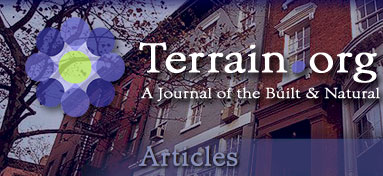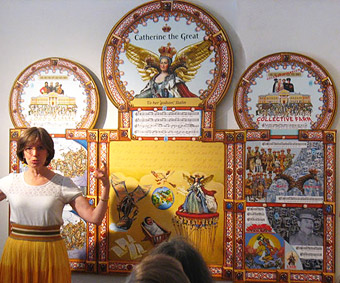
 |
|
|
A Hypertext Narrative Gallery by Anne Bobroff-Hajal  Anne Bobroff-Hajal gives an artist's gallery talk about her Playground of the Autocrats triptychs. Photo courtesy Anne Bobroff-Hajal. In the wake of work by Edward Tufte and others, “data visualization” has become a hot new field. Its ingenious practitioners transform data sets into images in often aesthetic ways, enabling us to grasp their significance with more speed and insight than by statistics alone. But what if our goal were to visualize not data points, but something more analog—say, ideas about how a given landscape sculpts a society inhabiting it? Could art achieve this? And what if we wanted to make viewers not only grasp ideas, but also gasp in horror? Could art engage both mind and emotions, both “right brain” and “left”? Triptych Artwork Playground of the Autocrats is a series of whimsical/serious mixed media triptychs I’ve been hatching over the last few years. They express my belief that the openness of Russia’s vast steppe terrain has been the spawning ground of its highly centralized state. Like comic books and graphic novels, Playground of the Autocrats tells stories through pictures. Playground’s tales are “narrated” in song by the likes of Ivan the Terrible and Catherine the Great. My effervescent imperial characters sound off through original lyrics I wrote to the tune of the famous Russian folksong, “Kalinka.” Viewers can either take in the spectacle as a whole, or navigate through the story via numbered panels.
Russia encompasses by far the largest plain on Earth (view The Most Exposed Terrain on Earth: Portraying Human Vulnerability on the Endless Steppe), making it uniquely vulnerable to enemy incursion. For five centuries during the formation of the Russian state, its most powerful enemies lived on the other side of that immense plain. No mountains obstructed raiders’ onslaughts. First the militarily brilliant Mongols dominated Russia, then their Tartar descendants the Nogay Horde, the Crimean Khanate and others, brutalized Russians virtually every year. Hundreds of thousands of Russians were abducted and sold into slavery in what was chillingly called “the harvesting of the steppe.” The Ottoman slave markets were a straight shot across the vast open plain. In fact, our word “slave” derives from “Slav.” Except for Africans, no other population on Earth has been enslaved more than the Slavs. Clearly there could be no rest for Russia’s defense. Every summer, every member of the Russian gentry was responsible for helping defend a southern border garrison for half the season. From the top nobility to the peasants in the field, Russians could never stand down. For five centuries, society had to be permanently organized as a military chain of command. Power bases independent of the commander-in-chief couldn’t develop because everyone was either at war or mobilizing for imminent attack (view Home Security at Any Crazy Price: What if We Had a 9/11 Every Year for Centuries?). Autocracy, cemented over so many centuries, created bureaucracies, mores, beneficiaries. Such a huge, lumbering system couldn’t change quickly. It tended to recur even after so-called revolutions (view Dress It Up in Resplendent Clothes: Stalin Builds on the Flatlands Past). Thus, the very shape of Russia’s landscape unleashed vast historical forces which in turn swept up hapless human beings (view Landscape Form and Military Defense, The Immense Russian Flatland, and Mongol Occupation and the Slav Slave Trade: The “Harvesting of the Steppe”). Continue by selecting a hypertext section...
Post Comment
|
|
||||||||||||||||||||||||||||||||||||||||||||||||||||||||||||||